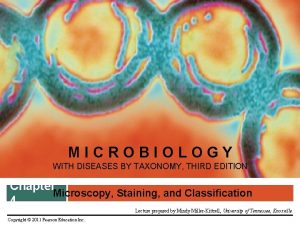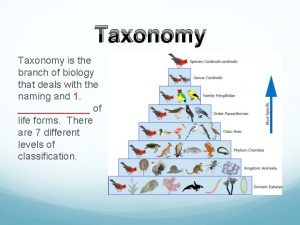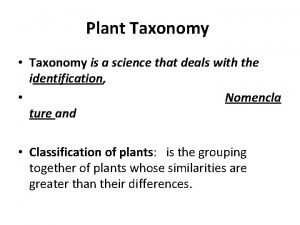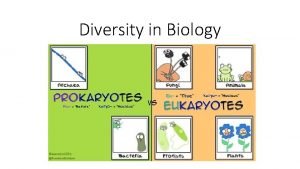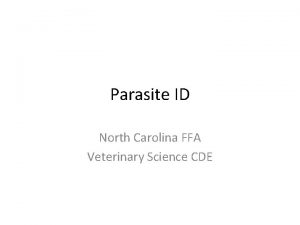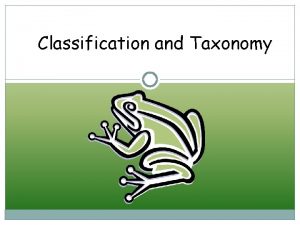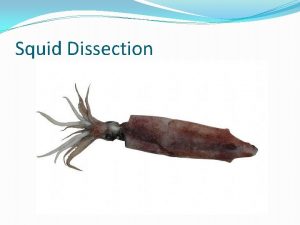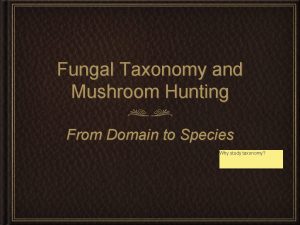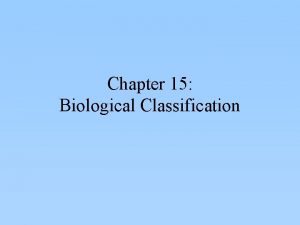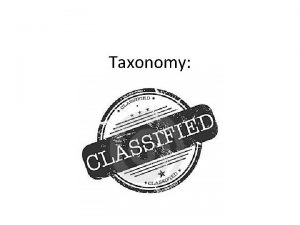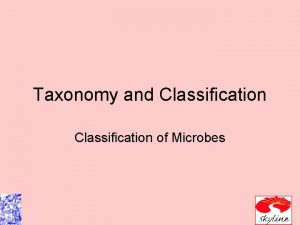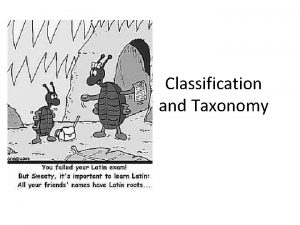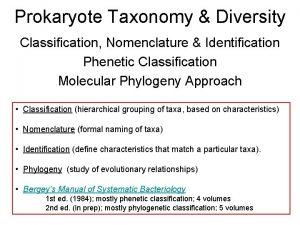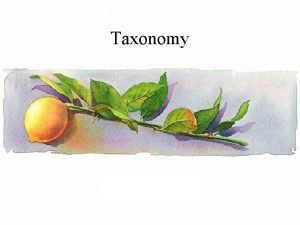CHAPTER 18 CLASSIFICATION CLASSIFICATION IDENTIFICATION Taxonomy science of

















- Slides: 17

CHAPTER 18 - CLASSIFICATION

CLASSIFICATION & IDENTIFICATION Taxonomy- science of classification � 1. Classification-assigning organisms to a taxa based on similarities � 2. Nomenclature- rules of naming � 3. Identification- determining belonging Important for: � sense of relationships, past to present � enhance communication- Doctors & scientists � make predictions about similar organisms

CAROLUS LINNAEUS Species-similar organisms that can interbreed � Didn’t work well for asexual organisms- called strains � Linnaeus divided into plantae & animalia only Taxon- group or level of classification � Kingdom, Phylum, Class, Order, Family, Genus, Species King Phillip Came Over For Good Spaghetti

The more of these that they have in common, the more closely related they are Ex: Ursus arctos (grizzly bear) Ursus maritimus (polar bear) Ailuropoda melanoleuca (Giant panda) Who is more closely related?

BINOMIAL NOMENCLATURE- 2 PART NAMING use Genus & species � Latin names � Genus-noun, written first, capitalized � Species- adjective, lowercase � *both written in italics or underlined � Ex: Diplococcus pneumoniae or Homo sapiens

PROBLEMS WITH COMMON NAMES 1. 2. 3. They don’t tell how organisms are related Misleading Vary from place to place

PHYLOGENETIC TREES diagram that depicts the lines of evolutionary descent of different species, organisms, or genes from a common ancestor

EVOLUTIONARY CLASSIFICATION Based on: 1. Phylogeny- evolutionary history � Modern day vs fossil record 2. Developmental stages- egg, larva, etc. 3. Biochemistry- DNA 4. Behavior- mating rituals, breeding seasons, calls

SYNAPOMORPHY- A SHARED, DERIVED CHARACTER The more recently two species diverged from a common ancestor, the more synapomorphies they will share. Unique synapomorphies found only in a single group provide strong evidence for the common ancestry of members of that group.

THE SYNAPOMORPHIC ASTRAGALUS ANKLE BONES OF WHALES (CETACEANS) AND CLOVEN-HOOVED MAMMALS (ARTIODACTYLS) HELPED BIOLOGISTS DETERMINE THAT THESE TWO GROUPS SHARE A RELATIVELY RECENT COMMON ANCESTOR.

CLADOGRAMS Diagrams that shows the evolutionary relationships among groups of organisms Uses derived characters- characteristics that appear in recent parts of a lineage but not in its older members


Construct a Cladogram Vertebrae Bony Skeleton Four Limbs Amniotic Egg Hair Large Holes in Skull Sharks X Ray-finned fish X X Amphibians X X X Primates X X X Rodents X X x Crocodiles X X X Dinosaurs & Birds x x x


18 -3 KINGDOMS & DOMAINS Robert Whittaker- 5 kingdom system � Plantae, Animalia, Fungi, Protista, Monera � Did not address viruses Today: 6 Kingdom System � Monera> Eubacteria & Archaebacteria

WOESE- 3 DOMAINS Determined by r. RNA sequencing 1. Archae- extreme bacteria 2. Bacteria- everyday bacteria 3. Eukarya- (Protista, Fungi, Plantae, Animalia)

CREATE YOUR OWN KEY:
 Kendall’s and marzano’s taxonomy
Kendall’s and marzano’s taxonomy Dichotomous key for microbiology
Dichotomous key for microbiology Positive identification
Positive identification What is your favorite subject and why science
What is your favorite subject and why science Thermodynamics is the branch of science that deals with
Thermodynamics is the branch of science that deals with Taxonomy non examples
Taxonomy non examples Taxonomy is the branch of science that deals with –
Taxonomy is the branch of science that deals with – Loculicidal capsule fruit
Loculicidal capsule fruit Taxonomy is the science that deals with
Taxonomy is the science that deals with Human domain and kingdom
Human domain and kingdom Ear mite
Ear mite How to write a scientific name
How to write a scientific name Dichotomous key for fungi
Dichotomous key for fungi Horse taxonomy
Horse taxonomy What is a dichotomous key? *
What is a dichotomous key? * Squid anatomy
Squid anatomy Mushroom domain
Mushroom domain Taxonomy worksheet chapter 15 answer key
Taxonomy worksheet chapter 15 answer key

